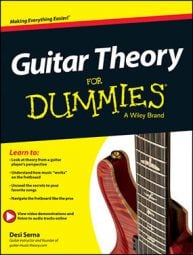Before you get started playing new types of chords on the guitar, some preliminary information about chord tones and extensions is necessary. You go beyond playing triad-based chords by adding in the degrees of the major scale other than 1, 3, and 5. These added chord tones are the 2nd, 4th, 6th, and 7th.
Sometimes chord tones extend an octave above the 7th. In this case, the chord tones are called extensions and are numbered to reflect their position in the register above the first seven degrees of the scale. For example, 2 becomes 9, 4 becomes 11, and 6 becomes 13.
| G | A | B | C | D | E | Fs | G | A | B | C | D | E | Fs |
| 1 | 2 | 3 | 4 | 5 | 6 | 7 | 8 | 9 | 10 | 11 | 12 | 13 | 14 |
In music theory, 1, 3, 5, and 7 are always counted the same regardless of register. Only 2, 4, and 6 get renumbered when they extend beyond the 7th. And they only get renumbered once. Transpose them up additional octaves and their numbers don’t increase.
When an extension like 9, 11, or 13 is present in a chord, then the 7th is supposed to be included too, plus any extensions before the one in the chord name. For example:
G major: 1-3-5, G-B-D
Gmaj7: 1-3-5-7, G-B-D-Fs
Gmaj9: 1-3-5-7-9, G-B-D-Fs-A
Gmaj11: 1-3-5-7-9-11, G-B-D-Fs-A-C
Gmaj13: 1-3-5-7-9-11-13, G-B-D-Fs-A-C-E
But, this isn’t always the way it’s done, as you soon see.
If an extension is added to a triad, but the 7th and other extensions aren’t also included, the term add is used. For example:
G: 1-3-5, G-B-D
Gadd9: 1-3-5-9, G-B-D-A
Gadd11: 1-3-5-11, G-B-D-C
Gadd13: 1-3-5-13, G-B-D-E
Moving onto sus chords, because of their proximity to the 3rd, 2 and 4 often replace the 3rd. When this happens, the chord becomes suspended and the abbreviation sus appears in the name. For example:
G: 1-3-5, G-B-D
Gsus2: 1-2-5, G-A-D
Gsus4: 1-4-5, G-C-D
The lack of a 3rd in sus chords creates an open, unresolved sound.
If a 2 or 4 is added but the 3rd remains, then the term add is used. For example:
Gadd2: 1-2-3-5, G-A-B-D
Gadd4: 1-3-4-5, G-B-C-D
But, remember, 2nds and 9ths are the same. So are 4ths and 11ths. So you may see the chords above stacked and written as follows:
Gadd9: 1-3-5-9, G-B-D-A
Gadd11: 1-3-5-11, G-B-D-C
Notice that these chords use the very same notes as the chords before them. The only difference is in how the notes are stacked and the chords named. But guitar players often stack chord members out of order anyway, so it’s hard to follow a strict convention. As a result, 2nds and 9ths and 4ths and 11ths are often used interchangeably.
Guitarists not only need to rearrange chord members at times but also leave some out in order to make a chord shape physically playable and pleasant sounding. This is especially true as you add more chord tones and extensions.
For example, a major 13th chord is supposed to be stacked 1-3-5-7-9-11-13. You don’t have enough fingers and strings for that! Obviously, something has to go. In cases like this, you at least try to retain the 3rd, the 7th, and the extension that the chord is named after. So a Gmaj13 might be played 1-3-7-13, 1-7-3-13, or some such combination.

